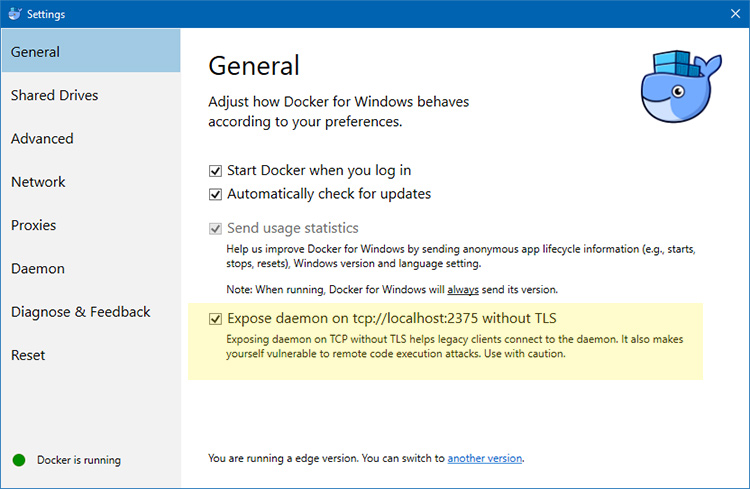Configure and troubleshoot the Docker daemon Estimated reading time: 11 minutes After successfully installing and starting Docker, the dockerd daemon runs with its default configuration. This topic shows how to customize the configuration, start the daemon manually, and troubleshoot and debug the daemon if you run into issues. Start the daemon using operating system utilities On a typical installation the Docker daemon is started by a system utility, not manually by a user. This makes it easier to automatically start Docker when the machine reboots. The command to start Docker depends on your operating system.
Check the correct page under. To configure Docker to start automatically at system boot, see. Start the daemon manually If you don’t want to use a system utility to manage the Docker daemon, or just want to test things out, you can manually run it using the dockerd command. You may need to use sudo, depending on your operating system configuration. When you start Docker this way, it runs in the foreground and sends its logs directly to your terminal.
$ dockerd INFO0000 +job initnetworkdriver INFO0000 +job serveapi (unix:///var/run/docker.sock ) INFO0000 Listening for HTTP on unix (/var/run/docker.sock ) To stop Docker when you have started it manually, issue a Ctrl+C in your terminal. Configure the Docker daemon There are two ways to configure the Docker daemon:.
Use a JSON configuration file. This is the preferred option, since it keeps all configurations in a single place. Use flags when starting dockerd. You can use both of these options together as long as you don’t specify the same option both as a flag and in the JSON file.
If that happens, the Docker daemon won’t start and prints an error message. To configure the Docker daemon using a JSON file, create a file at /etc/docker/daemon.json on Linux systems, or C: ProgramData docker config daemon.json on Windows. Here’s what the configuration file looks like. Dockerd -help Many specific configuration options are discussed throughout the Docker documentation.
Some places to go next include:. Docker daemon directory The Docker daemon persists all data in a single directory. This tracks everything related to Docker, including containers, images, volumes, service definition, and secrets. By default this directory is:. /var/lib/docker on Linux. C: ProgramData docker on Windows. You can configure the Docker daemon to use a different directory, using the data-root configuration option.
Since the state of a Docker daemon is kept on this directory, make sure you use a dedicated directory for each daemon. If two daemons share the same directory, for example, an NFS share, you are going to experience errors that are difficult to troubleshoot. Troubleshoot the daemon You can enable debugging on the daemon to learn about the runtime activity of the daemon and to aid in troubleshooting. If the daemon is completely non-responsive, you can also of all threads to be added to the daemon log by sending the SIGUSR signal to the Docker daemon. $ sudo kill -SIGHUP $(pidof dockerd ) On Windows hosts, restart Docker. Instead of following this procedure, you can also stop the Docker daemon and restart it manually with the debug flag -D.
However, this may result in Docker restarting with a different environment than the one the hosts’ startup scripts create, and this may make debugging more difficult. Force a stack trace to be logged If the daemon is unresponsive, you can force a full stack trace to be logged by sending a SIGUSR1 signal to the daemon. $ sudo kill -SIGUSR1 $(pidof dockerd ). Windows Server: Download. Run the executable with the flag -pid=. This forces a stack trace to be logged but does not stop the daemon.

Daemon logs show the stack trace or the path to a file containing the stack trace if it was logged to a file. The daemon continues operating after handling the SIGUSR1 signal and dumping the stack traces to the log.

The stack traces can be used to determine the state of all goroutines and threads within the daemon. View stack traces The Docker daemon log can be viewed by using one of the following methods:.
By running journalctl -u docker.service on Linux systems using systemctl. /var/log/messages, /var/log/daemon.log, or /var/log/docker.log on older Linux systems. By running Get-EventLog -LogName Application -Source Docker -After (Get-Date).AddMinutes(-5) Sort-Object Time Export-CSV /last5minutes.CSV on Docker EE for Windows Server Note: It is not possible to manually generate a stack trace on Docker for Mac or Docker for Windows. However, you can click the Docker taskbar icon and choose Diagnose and feedback to send information to Docker if you run into issues. Look in the Docker logs for a message like the following.goroutine stacks written to /var/run/docker/goroutine-stacks-2017-36z.log.daemon datastructure dump written to /var/run/docker/daemon-data-2017-36z.log The locations where Docker saves these stack traces and dumps depends on your operating system and configuration. You can sometimes get useful diagnostic information straight from the stack traces and dumps. Otherwise, you can provide this information to Docker for help diagnosing the problem.
How To Supply Dockers Options On Sale
Check whether Docker is running The operating-system independent way to check whether Docker is running is to ask Docker, using the docker info command. You can also use operating system utilities, such as sudo systemctl is-active docker or sudo status docker or sudo service docker status, or checking the service status using Windows utilities.
How To Supply Dockers Options For Women
Finally, you can check in the process list for the dockerd process, using commands like ps or top.,.
Hello I have problem with remove dead docker containers: root @ bespokeworktoptool3 /root ### docker ps CONTAINER ID IMAGE COMMAND CREATED STATUS PORTS NAMES root @ server /root ### docker ps -a CONTAINER ID IMAGE COMMAND CREATED STATUS PORTS NAMES 79ae723f9f1c docker.elastic.co/elasticsearch/elasticsearch:5.2.2 '/bin/bash bin/es.' 3 weeks ago Dead elasticsearch a31ce7855461 mobz/elasticsearch-head:5 '/bin/sh -c 'grunt.' 3 weeks ago Dead elasticsearchhead f2b27b8bc383 teamzeus/remote-syslog:0.19 '/bin/sh -c 'watch.'